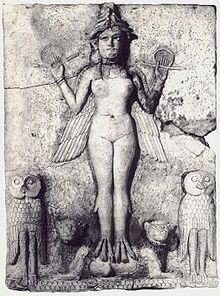| Revision as of 13:48, 29 August 2006 view sourceShulgi (talk | contribs)165 editsNo edit summary← Previous edit | Revision as of 13:53, 29 August 2006 view source Shulgi (talk | contribs)165 editsNo edit summaryNext edit → | ||
| Line 1: | Line 1: | ||
| ] | ] | ||
| The '''Burney Relief''', named after a former owner, is the common term for an early ] (ca. ]) ]n ]n, not ] or ], as sometimes described) terracotta relief of a winged goddess-like figure with ]'s talons, flanked by ]s and perched upon supine ]s. Though in private ownership for many years, it was well known through its former on-loan exhibition in the ] in ]. In 2003 it was bought by the Museum as part of its 250th anniversary celebrations and renamed "Queen of the Night", and since then has toured museums around Britain, with pagans in some locations being allowed to organize religious ceremonies in her honour. The figure has been identified with the Sumerian ''Kisikil-lilla-ke'' of the ], and, somewhat improbably, with ] Babylonian ]. Otherwise, she has been identified as the goddess ] (Sumerian) or ] (Babylonian), but due to her Underworld symbolism, the most likely identification is now thought to be Ereshkigal, Inanna's sister and Queen of the Underworld. | The '''Burney Relief''', named after a former owner, is the common term for an early ] (ca. ]) ]n ]n, not ] or ], as sometimes described) terracotta relief of a winged goddess-like figure with ]'s talons, flanked by ]s and perched upon supine ]s. Though in private ownership for many years, it was well known through its former on-loan exhibition in the ] in ]. In 2003 it was bought by the Museum as part of its 250th anniversary celebrations and renamed "Queen of the Night", and since then has toured museums around Britain, with pagans in some locations being allowed to organize religious ceremonies in her honour. The figure has been identified with the Sumerian ''Kisikil-lilla-ke'' of the ], and, somewhat improbably, with ] Babylonian ]. Otherwise, she has been identified as the goddess ] (Sumerian) or ] (Babylonian), but due to her ] symbolism, the most likely identification is now thought to be ], Inanna's sister and Queen of the Underworld. | ||
| The piece has sometimes, on stylistic grounds, been regarded as not genuine, but scientific testing now appears to confirm its authenticity. A very similar relief dating to roughly the same period is preserved in the ] (AO 6501). | The piece has sometimes, on stylistic grounds, been regarded as not genuine, but scientific testing now appears to confirm its authenticity. A very similar relief dating to roughly the same period is preserved in the ] (AO 6501). | ||
| ==References== | |||
Revision as of 13:53, 29 August 2006

The Burney Relief, named after a former owner, is the common term for an early 2nd millennium BC (ca. 1950 BC) Mesopotamian (Babylonian, not Sumerian or Assyrian, as sometimes described) terracotta relief of a winged goddess-like figure with eagle's talons, flanked by owls and perched upon supine lions. Though in private ownership for many years, it was well known through its former on-loan exhibition in the British Museum in London. In 2003 it was bought by the Museum as part of its 250th anniversary celebrations and renamed "Queen of the Night", and since then has toured museums around Britain, with pagans in some locations being allowed to organize religious ceremonies in her honour. The figure has been identified with the Sumerian Kisikil-lilla-ke of the Gilgamesh epos, and, somewhat improbably, with 7th century BC Babylonian Lilitu. Otherwise, she has been identified as the goddess Inanna (Sumerian) or Ishtar (Babylonian), but due to her Underworld symbolism, the most likely identification is now thought to be Ereshkigal, Inanna's sister and Queen of the Underworld.
The piece has sometimes, on stylistic grounds, been regarded as not genuine, but scientific testing now appears to confirm its authenticity. A very similar relief dating to roughly the same period is preserved in the Musée du Louvre (AO 6501).
References
F. Davis, "A puzzling "Venus" of 2000 B.C.: a fine Sumerian relief in London". The Illustrated London News 13 June 1936 (issue 5069) 1047. D. Opitz, "Die vogelfüssige Göttin auf den Löwen". Archiv für Orientforschung 11 (1936-37), 350-353. E.D. Van Buren, "A further note on the terra-cotta relief". Archiv für Orientforschung 11 (1936-37), 354-357. H. Frankfort, "The Burney Relief". Archiv für Orientforschung 12 (1937-39), 128-135. Th. Jacobsen, "Pictures and pictorial language (the Burney Relief). In: M. Mindlin, M.J. Geller and J.E. Wansbrough, eds., Figurative Language in the Ancient Near East, 1-11. London: University of London School of Oriental and African Studies.